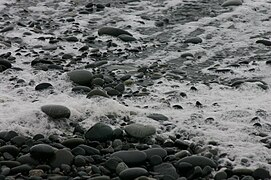Pebble
This article needs additional citations for verification. (December 2013) |

A pebble is a
A beach composed chiefly of surface pebbles is commonly termed a shingle beach. This type of beach has armoring characteristics with respect to wave erosion, as well as ecological niches that provide habitat for animals and plants.
Inshore banks of shingle (large quantities of pebbles) exist in some locations, such as the entrance to the
Pebbles come in various colors and textures and can have streaks, known as veins, of quartz or other minerals. Pebbles are mostly smooth but, dependent on how frequently they come in contact with the sea, they can have marks of contact with other rocks or other pebbles. Pebbles left above the high water mark may have growths of organisms such as lichen on them, signifying the lack of contact with seawater.
Location
Pebbles on Earth exist in two types of locations – on the beaches of various oceans and seas, and inland where ancient seas used to cover the land. Then, when the seas retreated, the rocks became landlocked. Here, they entered lakes and ponds, and form in rivers, travelling into estuaries where the smoothing continues in the sea.
Beach pebbles and river pebbles (also known as river rock) are distinct in their geological formation and appearance.
Beach

Beach pebbles form gradually over time as the ocean water washes over loose rock particles. The result is a smooth, rounded appearance. The typical size range is from 2 mm to 50 mm. The colors range from translucent white to black, and include shades of yellow, brown, red and green. Some of the more plentiful pebble beaches are along the coast of the Pacific Ocean, beginning in Canada and extending down to the tip of South America in Argentina. Other pebble beaches are in northern Europe (particularly on the beaches of the Norwegian Sea), along the coast of the U.K. and Ireland, on the shores of Australia, and around the islands of Indonesia and Japan.
Inland

Inland pebbles (river pebbles of river rock) are usually found along the shores of large rivers and lakes. These pebbles form as the flowing water washes over rock particles on the bottom and along the shores of the
Human use

Beach pebbles and river pebbles are used for a variety of purposes, both outdoors and indoors. They can be sorted by colour and size, and they can also be polished to improve the texture and colour. Outdoors, beach pebbles are often used for
Mars
On Mars, slabs of pebbly conglomerate rock have been found and have been interpreted by scientists as having formed in an ancient streambed. The gravels, which were discovered by NASA's Mars rover Curiosity, range from the size of sand particles to the size of golf balls. Analysis has shown that the pebbles were deposited by a stream that flowed at walking pace and was ankle- to hip-deep.[2]
Gallery
-
Pebbles given a rounded shape by wave action
-
Pebbles on a beach at Broulee, Australia
See also
References
- ^ "Ore and Alde, Rivers - East Coast: pilotage, charts, photos and marine business listings". www.visitmyharbour.com.
- ^ "NASA Rover Finds Old Streambed on Martian Surface". News. Jet Propulsion Laboratory / California Institute of Technology. 27 September 2012. Retrieved 28 February 2016.
External links
![]() Media related to Pebbles at Wikimedia Commons
Media related to Pebbles at Wikimedia Commons





